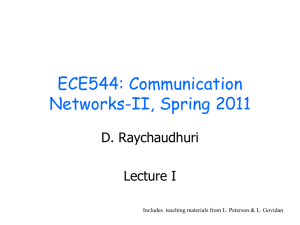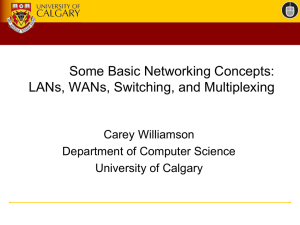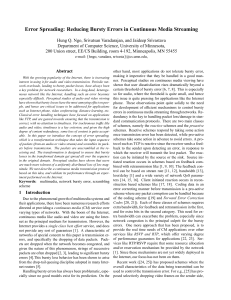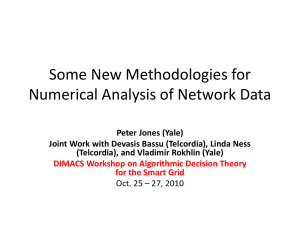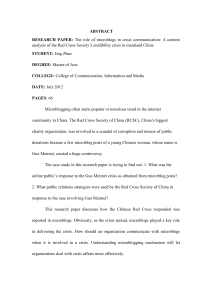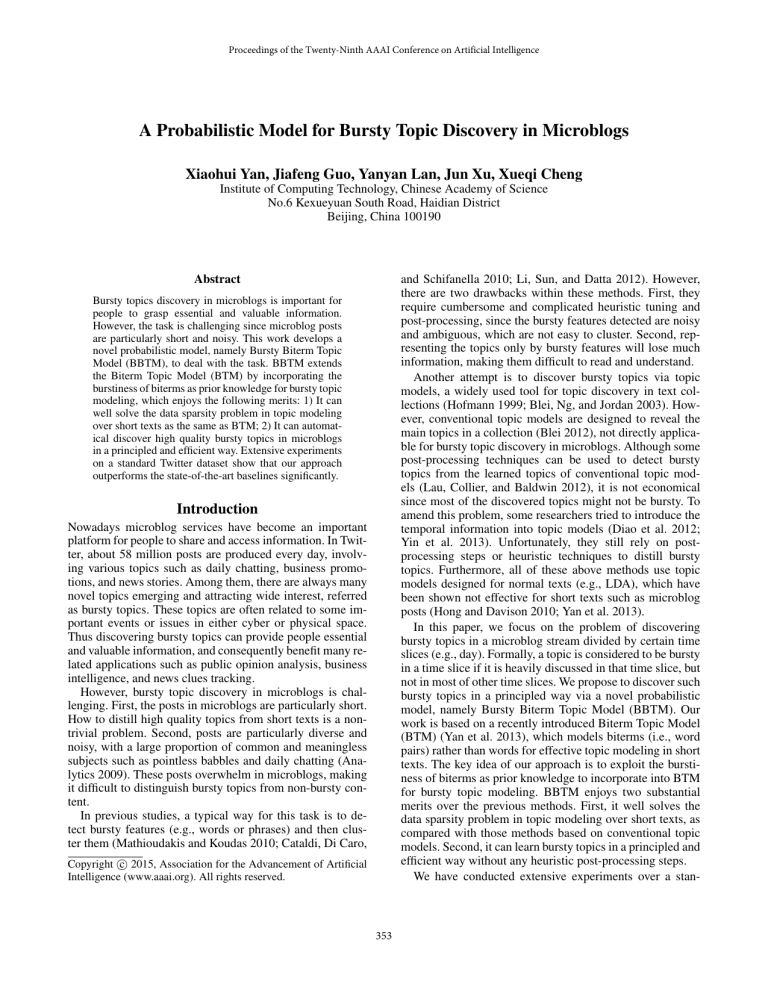
Proceedings of the Twenty-Ninth AAAI Conference on Artificial Intelligence
A Probabilistic Model for Bursty Topic Discovery in Microblogs
Xiaohui Yan, Jiafeng Guo, Yanyan Lan, Jun Xu, Xueqi Cheng
Institute of Computing Technology, Chinese Academy of Science
No.6 Kexueyuan South Road, Haidian District
Beijing, China 100190
Abstract
and Schifanella 2010; Li, Sun, and Datta 2012). However,
there are two drawbacks within these methods. First, they
require cumbersome and complicated heuristic tuning and
post-processing, since the bursty features detected are noisy
and ambiguous, which are not easy to cluster. Second, representing the topics only by bursty features will lose much
information, making them difficult to read and understand.
Another attempt is to discover bursty topics via topic
models, a widely used tool for topic discovery in text collections (Hofmann 1999; Blei, Ng, and Jordan 2003). However, conventional topic models are designed to reveal the
main topics in a collection (Blei 2012), not directly applicable for bursty topic discovery in microblogs. Although some
post-processing techniques can be used to detect bursty
topics from the learned topics of conventional topic models (Lau, Collier, and Baldwin 2012), it is not economical
since most of the discovered topics might not be bursty. To
amend this problem, some researchers tried to introduce the
temporal information into topic models (Diao et al. 2012;
Yin et al. 2013). Unfortunately, they still rely on postprocessing steps or heuristic techniques to distill bursty
topics. Furthermore, all of these above methods use topic
models designed for normal texts (e.g., LDA), which have
been shown not effective for short texts such as microblog
posts (Hong and Davison 2010; Yan et al. 2013).
In this paper, we focus on the problem of discovering
bursty topics in a microblog stream divided by certain time
slices (e.g., day). Formally, a topic is considered to be bursty
in a time slice if it is heavily discussed in that time slice, but
not in most of other time slices. We propose to discover such
bursty topics in a principled way via a novel probabilistic
model, namely Bursty Biterm Topic Model (BBTM). Our
work is based on a recently introduced Biterm Topic Model
(BTM) (Yan et al. 2013), which models biterms (i.e., word
pairs) rather than words for effective topic modeling in short
texts. The key idea of our approach is to exploit the burstiness of biterms as prior knowledge to incorporate into BTM
for bursty topic modeling. BBTM enjoys two substantial
merits over the previous methods. First, it well solves the
data sparsity problem in topic modeling over short texts, as
compared with those methods based on conventional topic
models. Second, it can learn bursty topics in a principled and
efficient way without any heuristic post-processing steps.
We have conducted extensive experiments over a stan-
Bursty topics discovery in microblogs is important for
people to grasp essential and valuable information.
However, the task is challenging since microblog posts
are particularly short and noisy. This work develops a
novel probabilistic model, namely Bursty Biterm Topic
Model (BBTM), to deal with the task. BBTM extends
the Biterm Topic Model (BTM) by incorporating the
burstiness of biterms as prior knowledge for bursty topic
modeling, which enjoys the following merits: 1) It can
well solve the data sparsity problem in topic modeling
over short texts as the same as BTM; 2) It can automatical discover high quality bursty topics in microblogs
in a principled and efficient way. Extensive experiments
on a standard Twitter dataset show that our approach
outperforms the state-of-the-art baselines significantly.
Introduction
Nowadays microblog services have become an important
platform for people to share and access information. In Twitter, about 58 million posts are produced every day, involving various topics such as daily chatting, business promotions, and news stories. Among them, there are always many
novel topics emerging and attracting wide interest, referred
as bursty topics. These topics are often related to some important events or issues in either cyber or physical space.
Thus discovering bursty topics can provide people essential
and valuable information, and consequently benefit many related applications such as public opinion analysis, business
intelligence, and news clues tracking.
However, bursty topic discovery in microblogs is challenging. First, the posts in microblogs are particularly short.
How to distill high quality topics from short texts is a nontrivial problem. Second, posts are particularly diverse and
noisy, with a large proportion of common and meaningless
subjects such as pointless babbles and daily chatting (Analytics 2009). These posts overwhelm in microblogs, making
it difficult to distinguish bursty topics from non-bursty content.
In previous studies, a typical way for this task is to detect bursty features (e.g., words or phrases) and then cluster them (Mathioudakis and Koudas 2010; Cataldi, Di Caro,
Copyright c 2015, Association for the Advancement of Artificial
Intelligence (www.aaai.org). All rights reserved.
353
Bursty Probability of Biterm
dard Twitter dataset. The experimental results demonstrate
that our approach achieves substantial improvement over the
state-of-the-art methods.
Intuitively, when a bursty topic breaks out, relevant biterms
can be observed more frequently than usual. For instance,
the biterms such as “world cup”, “football brazil” became
much more popular than usual in Twitter when World Cup
2014 took place. Such biterms provide us crucial clues for
bursty topic discovery. Based on the above observation, we
introduce a probability measurement, called bursty probability, to quantify the burstiness of biterms, which can be
estimated from the temporal frequencies of the biterms.
(t)
Suppose a biterm b occurred nb times in the posts published in time slice t. Since a biterm might be observed either in normal usage (e.g., daily chatting) or in some bursty
(t)
(t)
topic, we decompose nb into two parts: nb,0 is the count of
Biterm Topic Model
For completeness, we first briefly review the biterm topic
model (i.e., BTM) (Yan et al. 2013; Cheng et al. 2014),
a recently proposed probabilistic topic model for short
texts. Before BTM, most conventional topic models, such
as PLSA (Hofmann 1999) and LDA (Blei, Ng, and Jordan 2003), model each document as a mixture of topics, and thus suffer from the data sparsity problem when
documents are extremely short (Hong and Davison 2010;
Tang et al. 2014). Instead, BTM learns topics by modeling
the generation of biterms (i.e., unordered co-occurring word
pairs) in the collection, whose effectiveness are not affected
by the length of documents, making it more appropriate for
short texts.
The intuition of BTM is that if two words co-occur more
frequently, they are more likely to belong to a same topic.
Based on this idea, BTM models each biterm as two words
draw from a same topic, while a topic is drawn from a
mixture of topics over the whole collection. Specifically,
given a short text collection, suppose it contains NB biterms
B = {b1 , ..., bNB } where bi = (wi,1 , wi,2 ), and K topics expressed over W unique words, the generative process described by BTM is as follows:
(t)
biterm b occurred in normal usage, while nb,1 is the count
(t)
(t)
(t)
of b occurred in bursty topics, with nb,0 +nb,1 = nb . Note
(t)
(t)
that both nb,0 and nb,1 are not observed, however, we can
determine their value approximately based on the temporal
frequencies of b.
Specifically, for a large collection it is reasonable to assume that the normal usage of a biterm is stable during a
(t)
period of time. In other words, nb,0 is supposed to almost
(t)
be constant over time. Conversely, nb,1 may change significantly across different time slices. When some bursty topic
(t)
relevant to bi breaks out, nb,1 might rise steeply. while in
most other time slices, there is no such bursty topic taking
(t)
place, nb,1 will be close to 0. Based on the above analy-
1. For the collection,
• draw a topic distribution θ ∼ Dir(α)
(t)
(t)
sis, we estimate nb,0 by the mean of nb in the last S time
PS
(t−s)
(t)
. Consequently, we can obslices, i.e., n̄b = S1 s=1 nb
(t)
(t)
(t)
tain n̂b,1 = (nb − n̄b )+ , where (x)+ = max(x, ), and is a small positive number to avoid zero probability. In our
experiments, we set S = 10, = 0.01 after some preliminary
experiments.
(t)
(t)
With nb and n̂b,1 in hand, it is straightforward to measure the possibility of b generated from a bursty topic in time
slice t as:
(t)
(t)
(n − n̄ )+
(t)
ηb = b (t) b
.
(1)
nb
2. For each topic z,
• draw a word distribution φz ∼ Dir(β)
3. For each biterm bi ∈ B,
• draw a topic assignment z ∼ Multi(θ)
• draw two words wi,1 , wi,2 ∼ Mulit(φz )
where θ defines a K-dimensional multinomial distribution
over topics, and φz defines a W -dimensional multinomial
distribution over words. The graphical representation of
BTM is illustrated in Figure 1 (a).
(t)
We refer ηb as the bursty probability of biterm b in time
(t)
slice t. The calculation of ηb implies that a biterm occurred
much more frequently in a time slice than other time slices
will be more likely to be generated from bursty topics 1 .
Bursty Topic Modeling
BTM is an effective topic model over short texts but not
designed for bursty topic discovery. In other words, each
biterm occurrence contributes equally in BTM, but in microblogs a large proportion of biterms in microblogs are
about common topics such as daily life and chatting. Consequently, BTM tends to discover common topics in microblogs.
To discover bursty topics through BTM, it is important to
emphasize those biterms relevant to bursty topics and make
the model focus on these observations. Therefore, we introduce and quantify the burstiness of biterms and incorporate
it as prior knowledge into BTM for bursty topic discovery.
Bursty Biterm Topic Models
We now describe our approach for bursty topic modeling in
microblogs, i.e., Bursty Biterm Topic Model (BBTM). In the
following, since we focus on data in a single time slice, we
1
(t)
In our experiments, we found ηb in Eq. (1) might be overes(t)
timated for rare biterms whose n̄b issmall. Since the rare biterms
are more likely to be generated by random factors rather than bursty
(t)
(t)
(t)
topics, we set ηb to /nb if n̄b < 5.
354
α
β
φk
ηb
z
θ
Wi,1
K
α
θ
β
φk
ei
B
zi
Wi,2
NB
Wi,1
K+1
(a)
Wi,2
NB
(b)
Figure 1: Graphical representation of (a) the biterm topic model, and (b) the bursty biterm topic model.
will not specify the time slice in the notations. For instance,
(t)
we write ηb as ηb for simplification.
As we suppose that a biterm might be observed either
in normal usage or in some bursty topic, the basic idea of
BBTM is to distinguish the occurrences of biterms from the
two parts to learn bursty topics. Specifically, we define a binary variable ei to denote the source of an occurrence of
biterm bi . ei = 0 indicates bi is generated by normal usage, while ei = 1 indicates bi is generated from some bursty
topic. Recall that the bursty probability of a biterm encodes
our prior knowledge of how likely the biterm is generated
from a bursty topic, we thus define a Bernoulli distribution
with parameter ηbi as the prior distribution of ei . Moreover,
we introduce K multinomial distributions over the words
(i.e., {φk |k ∈ [1, K]}) to denote the bursty topics in the collection, and a background word distribution φ0 to denote the
normal usage. The generative process of the biterm set B in
the time slice in BBTM is then defined as follows:
Li, Sun, and Datta 2012) can only determine whether a
biterm is bursty or not, rather than the probability of a biterm
generated from bursty topics. Therefore, using them as the
prior will lead to inferior results, as shown in our preliminary
experiments.
The background word distribution introduced by BBTM
is used to filter out biterms not related to bursty topics. In
(Mei and Zhai 2005), a background word distribution is also
introduced into a topic model to distill temporal themes from
a text stream. However, the background word distribution is
simply set to the empirical word distribution that contributes
equally on the generation of each word. In BBTM, the background word distribution is learned from the data. Its impact
on the generation of biterms is different due to the bitermwise prior ηb .
Parameter Estimation
1. For the collection,
• draw a bursty topic distribution θ ∼ Dir(α)
• draw a background word distribution φ0 ∼ Dir(β)
2. For each bursty topic k ∈ [1, K],
• draw a word distribution φk ∼ Dir(β)
3. For each biterm bi ∈ B
• draw ei ∼ Bern(ηbi )
• If ei = 0,
– draw two words wi,1 , wi,2 ∼ Multi(φ0 )
• If ei = 1,
– draw a bursty topic z ∼ Multi(θ)
– draw two words wi,1 , wi,2 ∼ Multi(φz )
In BBTM, the parameter set need to estimate is Θ =
{θ, φ0 , ..., φK }, if given the hyperparameters α and β. It
is not hard to write out the likelihood of the biterm set B:
P (B)
=
NB Z Y
φ0,wi,1 φ0,wi,2 (1 − ηbi ) +
i=1
K
X
θk φk,wi,1 φk,wi,2 ηbi dΘ.
(2)
k=1
Its graphical representation is shown in Figure 1 (b), where
B denotes the number of distinct biterms in B.
Since the parameters in Θ are coupled in Eq. (2), it is intractable to determine them exactly. Following (Griffiths and
Steyvers 2004), we use the collapsed Gibbs sampling algorithm for approximate estimation.
Discussion
In BBTM, the prior distribution ηb indicates how likely a
biterm b is generated by bursty topics, which plays a key
role in guiding the model to distinguish whether a biterm b
is generated from burst topics or not. Previous work measuring word burstiness with statistical testing (Swan and
Allan 1999; Lijffijt 2013) or sigmoid mapping of the variance of temporal frequencies of words (Fung et al. 2005;
The basic idea is to estimate the parameters alternatively
using samples drawn from the posterior distributions of latent variables sequentially conditioned on the current values of all other variables and the data. In BBTM, there are
two types of latent variables, i.e., ei and zi . We draw them
jointly according to the following conditional distribution
355
tatively and qualitatively.
Algorithm 1: Gibbs sampling algorithm for BBTM
Input: K, α, β, B
Output: {φk }K
k=0 , θ
Randomly initialize e and z
for iter = 1 to Niter do
foreach bi = (wi,1 , wi,2 ) ∈ B do
Draw ei , k from Eqs.(3-4)
if ei = 0 then
Update the counts n0,wi,1 , n0,wi,2
else
Update the counts nk , nk,wi,1 , nk,wi,2
Experimental Settings
Dataset. We use a standard microblog dataset, i.e., the
Tweets2011 collection published in TREC 2011 microblog
track2 . The dataset contains approximately 16 million tweets
sampled in 17 days from Jan. 23 to Feb. 8, 2011. We preprocessed the raw data in the same way as (Yan et al. 2013).
Furthermore, we filtered biterms occurred only one time in
the collection to save computational cost since most of them
are meaningless.
Baseline Methods. We compare our approach against the
following baseline methods: 1) Twevent (Li, Sun, and Datta
2012) first detects bursty tweet segments and then clustering
them to obtain bursty topics. To make a fair comparison, we
simply used individual words as segments, and did not exploit Wikipedia to filter the final clusters. 2) OLDA (Lau,
Collier, and Baldwin 2012) uses online LDA (AlSumait,
Barbará, and Domeniconi 2008) to learn topics in each
time slice, and then detects bursty topics by measuring the
Jensen-Shannon divergence between the words distribution
before and after an update of the topics. 3) UTM (UserTemporal Mixture model) (Yin et al. 2013) supposes the
temporal topics follow a time-dependent topic distribution,
and the non-bursty topics follow a user-dependent topic distribution. To ensure the temporal topics discovered to be
bursty, the authors heuristically boosted the probability of
bursty words in the temporal topics. 4) IBTM trains individual BTM (Yan et al. 2013) for each time slice. To distinguish
between bursty topics and non-bursty topics, we first greedily matched the topics in two adjacent time slices according their cosine similarity, and then used the post-processing
step in OLDA to detect bursty topics. 5) BBTM-S is a simplified version BBTM. In BBTM-S, for each occurrence of
biterm bi , we directly draw ei from a Bernoulli distribution
with parameter ηbi , rather than take it as a latent variable.
If ei = 1, bi is selected into the training set, otherwise it is
discarded. Finally, we simply train a BTM over the selected
biterms to learn the bursty topics.
Parameter Setting. In our experiments, the length of a
time slice is set to a day, a typical setting in the literature (Lau, Collier, and Baldwin 2012; Li, Sun, and Datta
2012). Following the convention in BTM (Yan et al. 2013),
we set α = 50/K and β = 0.01 in BBTM. The number of
bursty topics K are varied from 10 to 50. The other parameters of the baseline methods are set by their default values
in their papers.
Compute the parameters by Eqs. (5-6)
(the derivation is provided in the supplemental material):
P (ei = 0|e¬i , z¬i , B, α, β, η) ∝
+ β)(n¬i
(n¬i
0,wi,2 + β)
0,w
(1 − ηbi ) · ¬i i,1
, (3)
¬i
(n0,· + W β)(n0,· + 1 + W β)
P (ei = 1, zi = k|e¬i , z¬i , B, α, β, η) ∝
(n¬i
+ β)(n¬i
(n¬i + α)
k,w
k,wi,2 + β)
,
· ¬i i,1
ηbi · ¬ik
¬i
(n· + Kα) (nk,· + W β)(nk,· + 1 + W β)
(4)
NB
B
B
where e = {ei }i=0
, z = {zi }N
i=0 , η = {ηb }b=0 , n0,w is
the number of times that word w is assigned to the backPW
ground word distribution, n0,· =
w=1 n0,w is the total
number of words assigned to the background word distribution, nk is the number of biterms assigned to bursty topic
PK
k, n· = k=1 nk is the total number of biterms assigned
to bursty topics, nk,w is the number of times that word w
PW
is assigned to bursty topic k, nk,· = w=1 nk,w is the total
number of words assigned to bursty topic k, and ¬i means
ignoring biterm bi .
The Gibbs sampling algorithm of BBTM is outlined in Algorithm 1. First, we randomly initialize the latent variables.
Then, we iteratively draw samples of the latent variables for
each biterm according to Eqs. (3-4). After a sufficient number of iterations, we collect the counts nk and nk,w to estimate the parameters by:
nk,w + β
,
(5)
φ̂k,w =
nk,· + W β
nk + α
θ̂k =
.
(6)
n· + Kα
Runtime Analysis. Recall that the time complexity of
BTM is O(Niter KNB ) and the memory complexity is
K(1+W )+NB (Yan et al. 2013), where NB is the number
of biterms in B. Compared with BTM, BBTM introduces an
additional topic, namely the background word distribution,
thus its time complexity is O(Niter (K + 1)NB ). Moreover,
it need to maintain η in memory, so its memory complexity
is (K +1)(1+W )+NB +B.
Accuracy of Bursty Topics Discovered
First of all, we evaluate the accuracy of the bursty topics discovered by different methods. We asked 5 volunteers to manually label the bursty topics discovered by all
of these methods. To ensure unbiased judgment, all the topics generated are randomly mixed before labeling. For each
bursty topic, we provided the volunteers its 50 most probable words and time slice information, and external tools,
such as Google and Twitter search, to help their judgement.
Experiments
In this section, we empirically verify the performance of
BBTM on bursty topic discovery in microblogs both quanti-
2
356
http://trec.nist.gov/data/tweets/
P@10
0.592
0.565
0.231
0.300
0.785
0.810
P@30
0.681
0.488
0.217
0.325
0.832
0.865
2
P@50
0.636
0.453
0.185
0.297
0.790
0.842
1.8
1.6
Twevent
UTM
OLDA
IBTM
BBTM-S
BBTM
1.4
PMI-Score
Method
Twevent
UTM
OLDA
IBTM
BBTM-S
BBTM
1.2
1
0.8
0.6
0.4
0.2
Table 1: Accuracy of the bursty topics discovered (measured
by Precision@K).
0
10
20
30
40
50
Bursty Topic Number K
Figure 2: Coherence of the bursty topics discovered (measured by PMI-Score).
If the bursty topic presented is both meaningful and bursty
in its time slice, it gets 1 point; Otherwise, it gets 0 point. A
bursty topic is correctly detected if more than half of judges
assigned 1 point to it. The comparison of different methods
are then based on the average precision at K (P @K), i.e.,
the proportion of correctly detected busty topics among the
learned K bursty topics.
Table 1 lists the precisions of all the methods with different settings of bursty topic number K. We find that 1)
BBTM always achieves a high precision over 0.8, which is
substantially better than other methods. 2) The simplified
version of BBTM, i.e., BBTM-S, falls behind BBTM but
works much better than other baselines. We analyze the reason why BBTM-S is worse than BBTM. We find that the
biterm sampling process simply using the prior distribution
may throw away some potential bursty biterms with moderate busty probability. Meanwhile, from Eq. (4) we can
see that the topic assignment of bi is actually affected by
two factors simultaneously. One is the prior knowledge encoded by bursty probability, and the other is co-occurrence
patterns with other biterms in the time slice. By preserving
all the biterms and modeling the two parts jointly, BBTM
thus can better capture the bursty topics. 3) Twevent outperforms other baseline methods that based on topic models
(i.e., OLDA, UTM and IBTM). Further examination shows
that many topics discovered by these topic model based
methods are still about common subjects such as sentiment
and life. 4) Moveover, we also find that IBTM outperforms
OLDA though they use the same post-processing step, indicating that BTM can better model topics over short texts
than LDA.
For qualitative analysis, in Table 2 we show 5 bursty topics (represented by the most probable words) discovered by
BBTM along with the corresponding topic probability, i.e.,
θ̂k . To help us better understand the results, we also present a
news title for each topic obtained by searching its keywords
and date in Google. We can see that the 5 bursty topics coincide well with the real-world events reported by the news
titles, suggesting the good detection accuracy and potential
value of our approach on event detection and summarization.
Wikipedia data. A larger PMI-Score indicates the topic is
more coherent.
The result is shown in Figure 2. We have the following
observations. 1) The PMI-Score of BBTM is comparable to
IBTM and almost always the highest, indicating good coherence of the learned bursty topics from microblogs. 2)
BBTM-S achieves a comparable PMI-Score with OLDA
which is substantially higher than UTM and Twevent. However, BBTM-S is lower than BBTM, since it loses a large
part of useful word co-occurrence information by filtering
the biterms. 3) The PMI-Score of Twevent is always the lowest, indicating that topics obtained by simply clustering the
bursty words might be noisy and less coherent. 4) The PMIScore of UTM is lower than the other topic model based
methods. An explanation is that UTM heuristically boosts
the probability of bursty words in the temporal topics, which
might disturb the topic learning process and degrade the
quality of the learned topics.
For qualitative analysis, we chose a hot bursty topic by
selecting a hashtag with high bursty probability estimated
by Eq.(1). The hashtag is “#ntas” occurred in Jan. 26, 2011,
which denotes NTA (National Television Awards), a prominent ceremony in British held on that day. For comparison, we first calculate the empirical word distribution in the
tweets containing the hashtag. Then for each method, we
select the bursty topic closest to the empirical word distribution of the hashtag under the cosine similarity, and list the
results in Table 3.
From Table 3, we can see that: 1) The bursty topics discovered by BBTM is the closest to NTA, and even better
explains NTA than the empirical word distribution by ranking some common words such as “morning” and “doctor”
in lower position. 2) The bursty discovered BBTM-S is also
clearly about NTA, but slightly less readable than BBTM. 3)
The bursty topic discovered by Twevent is not well readable,
though the words are bursty in the data. UTM seems to have
the same problem of Twevent, since it boosts the probability of burst words in each topic in a heuristic way. 4) The
topics discovered by OLDA and BTM are relevant to NTA,
but they contain many common words such as “year” and
“good”, suggesting that it is a common issue of the standard
topic models.
Coherence of Bursty Topics Discovered
Next, we evaluate the interpretability of the learned bursty
topics based on the coherence measure. One popular metric
is the PMI-Score (Newman et al. 2010), which calculates
the average Pointwise Mutual Information (PMI) between
the most probable words in each topic using the large-scale
357
k
2
11
15
25
26
The 10 most probable words
police officers shot shooting detroit twitter adam suspect year revenue
(Two St. Petersburg police officers were shot and killed)
airport moscow police news killed people dead blast suicide explosion
(Deadly suicide bombing hits Moscow’s Domodedovo airport)
open #ausopen nadal australian murray mike tomlin cloud #cloud avril
(Australian Open Tennis Championships 2011)
jack lalanne fitness 96 dies guru rip died age dead
(Jack LaLanne: US fitness guru who last ate dessert in 1929 dies aged 96)
court emanuel rahm chicago ballot mayor mayoral run appellate rules
(Court tosses Emanuel off Chicago mayoral ballot)
θ̂k
0.036
0.057
0.015
0.044
0.024
Table 2: Bursty topics discovered by BBTM on Jan. 24, 2011. The sentences in parenthesis are news titles corresponding to
these topics obtained by querying the most probable words and its date in Google.
Empirical
#ntas
win
love
award
matt
morning
watching
doctor
lacey
cardle
Twevent
#thegame
malik
ant
melanie
eastenders
derwin
#ntas
tosh
nta
corrie
UTM
#thegame
malik
sitting
standing
cut
empty
pres
reform
remind
ai
OLDA
amazing
vote
award
movie
year
listen
awesome
film
king
music
IBTM
award
shorty
nominate
oscar
awards
#ntas
film
win
love
good
BBTM-S
award
win
bell
taco
high
shortly
speed
nominate
#ntas
rail
BBTM
#ntas
award
awards
win
#nta
national
love
tv
television
nta
Table 3: The bursty topic discovered by each method mostly relates to “#ntas” on Jan.26, 2011. The first column list the most
frequent words in the tweets with hashtag “#ntas”.
Novelty of Bursty Topics Discovered
1
0.9
In microblogs, we know that the content of bursty topics
change continually. We would like to compare the sensitivity of these methods on discovering novel bursty topics by
evaluating the novelty of the learned bursty topics across different time slice 3 . Specifically, given a topic set sequence
{Z(0) , ..., Z(t) }, we collect the T most probable words of
each topic in Z(t) to construct a topical word set W(t) for
each time slice. Then, we define the novelty of Z(t) as the
ratio of novel words in the topical word set, compared to the
last time slice. Formally:
Novelty(Z(t) ) =
0.8
Twevent
OLDA
BBTM-S
BBTM
IBTM
Novelty
0.7
0.6
0.5
0.4
0.3
0.2
0.1
0
10
20
30
40
50
Bursty topic Number K
Figure 3: Novelty of the bursty topic discovered.
|W(t) | − |W(t) ∩ W(t−1) |
,
T ∗K
words. However, the novelty decreases fast with the increase
of topic number K. Further investigation found that the reason is that many small-sized clusters (e.g., with 2 or 3 words)
are discovered by Twevent.
where | · | denotes the number of elements of a set. In our
experiments, we chose T = 10.
In Figures 3, we plot the change of the novelty of the
bursty topics as a function of the bursty topic number K.
We observe that 1) Both BBTM and BBTM-S significantly
outperform OLDA and IBTM, especially when K is large,
implying these two bursty oriented methods are more sensitive to bursty topics in microblogs than the temporal topic
models. 2) Twevent obtains a very high novelty when K
is small, since it summarizes burst topics only with bursty
Efficiency Comparison
Finally, we compare the training time of the methods based
on topic models. The experiments are conducted on a personal computer with two Dual-core 2.6GHz Intel processors
and 4 GB of RAM, and all the codes are implemented in
C++. We summarize the average runtime of per iteration
over microblog posts in a single day in Table 4. It is not
3
Since UTM is a retrospective topic detection model that models topics as static over time, we do not compare it here.
358
K
10
20
30
40
50
UTM
4.24
6.02
7.84
9.79
11.63
OLDA
1.84
2.61
3.28
4.02
4.83
IBTM
4.66
5.97
7.24
8.54
9.99
BBTM-S
0.03
0.06
0.09
0.13
0.17
BBTM
1.57
2.89
4.40
5.71
7.24
Blei, D. M. 2012. Probabilistic topic models. Communications of the ACM 55(4):77–84.
Cataldi, M.; Di Caro, L.; and Schifanella, C. 2010. Emerging topic detection on twitter based on temporal and social
terms evaluation. In MDMKDD, 4. ACM.
Cheng, X.; Yan, X.; Lan, Y.; and Guo, J. 2014. BTM: Topic
modeling over short texts. IEEE Transactions on Knowledge
and Data Engineering.
Diao, Q.; Jiang, J.; Zhu, F.; and Lim, E.-P. 2012. Finding
bursty topics from microblogs. In ACL, 536–544.
Fung, G. P. C.; Yu, J. X.; Yu, P. S.; and Lu, H. 2005. Parameter free bursty events detection in text streams. In Proceedings of the 31st international conference on Very large data
bases, 181–192. VLDB Endowment.
Griffiths, T. L., and Steyvers, M. 2004. Finding scientific
topics. PNAS 101(Suppl 1):5228–5235.
Hofmann, T. 1999. Probabilistic latent semantic analysis.
UAI.
Hong, L., and Davison, B. 2010. Empirical study of topic
modeling in Twitter. In Proceedings of the First Workshop
on Social Media Analytics, 80–88. ACM.
Lau, J. H.; Collier, N.; and Baldwin, T. 2012. On-line trend
analysis with topic models:#twitter trends detection topic
model online. In COLING, 1519–1534.
Li, C.; Sun, A.; and Datta, A. 2012. Twevent: segment-based
event detection from tweets. In CIKM, 155–164. ACM.
Lijffijt, J. 2013. A fast and simple method for mining subsequences with surprising event counts. In ECML PKDD
2013, Prague, Czech Republic, Proceedings, Part I, 385–
400.
Mathioudakis, M., and Koudas, N. 2010. Twittermonitor:
Trend detection over the twitter stream. In SIGMOD, 1155–
1158. New York, NY, USA: ACM.
Mei, Q., and Zhai, C. 2005. Discovering evolutionary theme
patterns from text: an exploration of temporal text mining.
In Proceedings of the eleventh ACM SIGKDD international
conference on Knowledge discovery in data mining, 198–
207. ACM.
Newman, D.; Lau, J. H.; Grieser, K.; and Baldwin, T. 2010.
Automatic evaluation of topic coherence. In NAACL HLT,
100–108.
Swan, R., and Allan, J. 1999. Extracting significant time
varying features from text. In Proceedings of the eighth international conference on Information and knowledge management, 38–45. ACM.
Tang, J.; Meng, Z.; Nguyen, X.; Mei, Q.; and Zhang, M.
2014. Understanding the limiting factors of topic modeling
via posterior contraction analysis. In ICML, 190–198.
Yan, X.; Guo, J.; Lan, Y.; and Cheng, X. 2013. A biterm
topic model for short texts. In WWW, 1445–1456.
Yin, H.; Cui, B.; Lu, H.; Huang, Y.; and Yao, J. 2013. A
unified model for stable and temporal topic detection from
social media data. In ICDE, 661–672. IEEE.
Table 4: Time cost (second) per iteration.
surprising that BBTM-S costs much less time than other
methods, since it only used a subset of biterms for training.
We also find that BBTM is much efficient than IBTM and
UTM, since it focuses on learning busty topics and spends
much less time on learning non-bursty topics. Note that both
BBTM and BBTM-S do not require any post-processing
steps as OLDA and IBTM, which will cost additional time.
Conclusions & Future Work
We study the problem of bursty topics discovery in microblogs, which is challenging due to the microblog posts
are particularly short and noisy. To tackle this problem, we
develop a novel bursty biterm topic model (i.e., BBTM)
based on the recently introduced short text topic model
(i.e., BTM). The key idea is to exploit the burstiness of
biterms as the prior knowledge and incorporate it into BTM
in a principled way for bursty topic modeling. Our approach can not only well solve the data sparsity problem
in topic modeling over short texts, but also automatically
learn bursty topics in a efficient way. Experimental results
demonstrate the substantial superiority of our approach over
the state-of-the-art methods.
For the future work, we would like to further improve the
estimation of bursty probability by including more information of the biterms. It would also be interesting to investigate how to model the microblog streams together with other
streaming data, like news streams, to better detect and represent bursty topics.
Acknowledgements
This work is funded by the National Basic Research
Program of China under Grants No. 2014CB340401,
No. 2012CB316303, National High Technology Research
and Development Program of China under Grant No.
2012AA011003, No. 2014AA015103, National Natural Science Foundation of China under Grant No. 61232010,
61472401, and National Key Technology R&D Program under Grant No. 2012BAH39B04. We would like to thank the
anonymous reviewers for their valuable comments.
References
AlSumait, L.; Barbará, D.; and Domeniconi, C. 2008. Online LDA: Adaptive topic models for mining text streams
with applications to topic detection and tracking. In ICDM,
3–12. IEEE.
Analytics, P. 2009. Twitter study–august 2009. San Antonio,
TX: Pear Analytics.
Blei, D.; Ng, A.; and Jordan, M. 2003. Latent Dirichlet
allocation. JMLR 3:993–1022.
359


